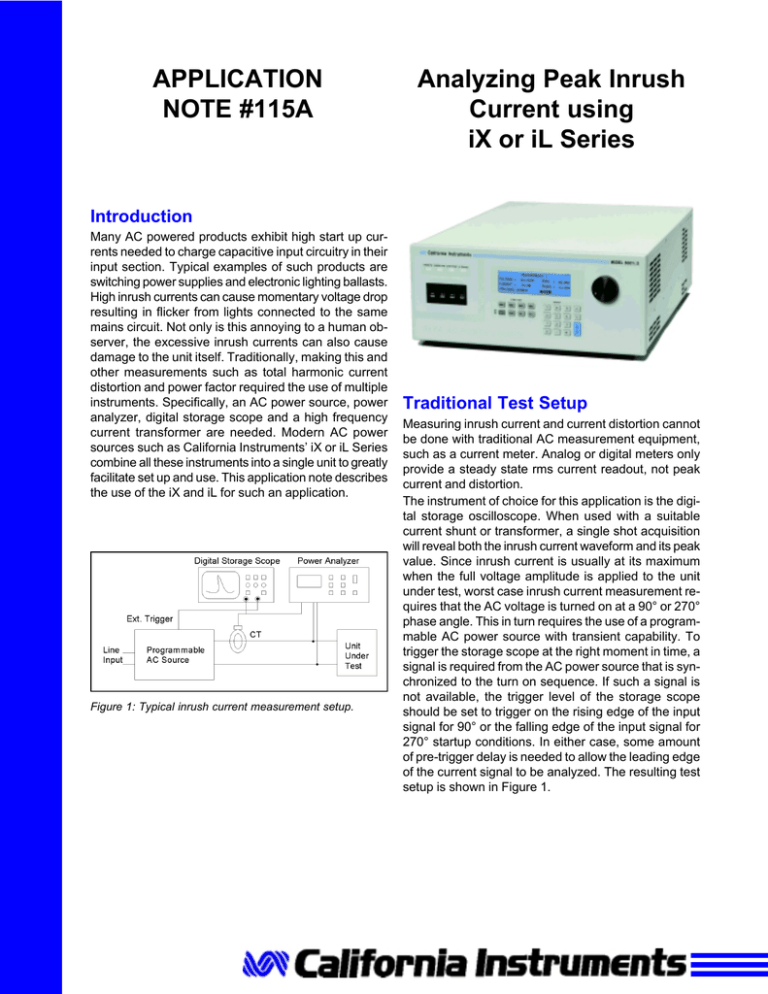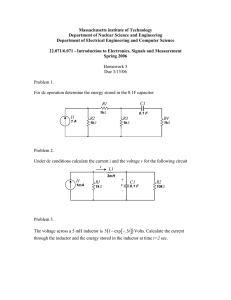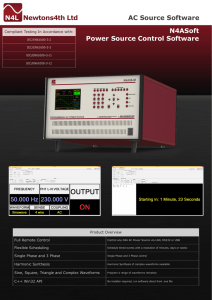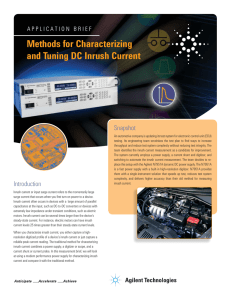Analyzing Peak Inrush Current using iX or iL Series
advertisement

APPLICATION NOTE #115A Analyzing Peak Inrush Current using iX or iL Series Introduction Many AC powered products exhibit high start up currents needed to charge capacitive input circuitry in their input section. Typical examples of such products are switching power supplies and electronic lighting ballasts. High inrush currents can cause momentary voltage drop resulting in flicker from lights connected to the same mains circuit. Not only is this annoying to a human observer, the excessive inrush currents can also cause damage to the unit itself. Traditionally, making this and other measurements such as total harmonic current distortion and power factor required the use of multiple instruments. Specifically, an AC power source, power analyzer, digital storage scope and a high frequency current transformer are needed. Modern AC power sources such as California Instruments’ iX or iL Series combine all these instruments into a single unit to greatly facilitate set up and use. This application note describes the use of the iX and iL for such an application. Figure 1: Typical inrush current measurement setup. Traditional Test Setup Measuring inrush current and current distortion cannot be done with traditional AC measurement equipment, such as a current meter. Analog or digital meters only provide a steady state rms current readout, not peak current and distortion. The instrument of choice for this application is the digital storage oscilloscope. When used with a suitable current shunt or transformer, a single shot acquisition will reveal both the inrush current waveform and its peak value. Since inrush current is usually at its maximum when the full voltage amplitude is applied to the unit under test, worst case inrush current measurement requires that the AC voltage is turned on at a 90° or 270° phase angle. This in turn requires the use of a programmable AC power source with transient capability. To trigger the storage scope at the right moment in time, a signal is required from the AC power source that is synchronized to the turn on sequence. If such a signal is not available, the trigger level of the storage scope should be set to trigger on the rising edge of the input signal for 90° or the falling edge of the input signal for 270° startup conditions. In either case, some amount of pre-trigger delay is needed to allow the leading edge of the current signal to be analyzed. The resulting test setup is shown in Figure 1. The use of a suitable Current transformer ensures proper isolation between the equipment under test (EUT) and the scope. If a current shunt is used, care should be taken to connect the scope probe ground to the neutral side of the AC source. Scope ground leads are normally connected to the scope chassis which is grounded to earth ground through the line cord. The alternative is to use an isolation amplifier or a battery powered storage scope. To capture a sufficient time window, the memory depth of the storage scope used is more important than its maximum sampling rate. Since most of these measurements involve 50 or 60 Hz fundamental frequencies, a 100 msecond time window using a 1 K memory depth in the storage scope only requires a 10 Ks/s sampling rate. (1K * 100 msec = 100 msec). This is equivalent to a time base setting of 10 msec/div. The deeper the storage scope’s memory, the higher the sampling rate will be at the same time base setting. Figure 2: Inrush current measurement setup using iX or iL Series AC power source. Single Instrument Solution The California Instruments iX and iL Series AC power sources are equipped with a two or six channel integrated digital storage scope that can be triggered internally to any AC transient program executed by the source. This eliminates the need for any additional equipment to make this kind of measurement. Not only does this provide a much faster way to set up and make this measurement, the 18 bit accuracy of the built in storage scope outperforms most digital storage scopes on the market that use 8 to 10 bit flash converters. Each of the available data acquisition channels - three for phase A, B and C voltage and three for phase A, B and C current - offers 4K sample memory. Figure 3: Transient Program with measurement trigger at step 2. Measurement Setup To determine the inrush current and current distortion for a compact fluorescent light ballast, the following setup is required. A Windows™ Graphical User Interface program, which is included with every California Instruments AC power source, provides access to all the AC source capabilities without the need to develop custom programs. The bulb used in this application is a 28 Watt, home consumer Compact Fluorescent Light (CFL) equivalent to a 75 W incandescent light bulb. The ballast electronics are integrated into the base of the bulb. Only phase A is required for this application so a 3001iX AC source is used. The load is connected to the phase A terminals. No other connections are required. To determine the maximum inrush current, the AC source is programmed to turn on 120 V rms at 90°. This produces the maximum voltage slew rate on the ballast’s input. A single line transient program set up with the GUI is needed to accomplish this task as shown in Figure 3. Figure 4: Voltage applied to EUT at 90° start phase angle. In order to trigger the internal storage scope at the right moment in time, the measurement trigger is set to transient step no. 1. Transient programs can have up to 100 steps and any step can be assigned as the trigger point for the internal storage scope. The voltage waveform that results from this transient program can be shown by displaying the Phase A voltage waveform as shown in figure 4. Notice the - 10 msec of pre-trigger delay that were used to provide a good view of the leading edge of the signal. The sampling rate is 40 Ks/s or a 25 microsecond sampling interval. Combined with the 4K memory depth, this results in a 100 msec time window. The display can be zoomed in or out to provide more or less detail. The current waveform is always sampled synchronously to the voltage waveform. The high inrush current of 26.32 A peak is shown at the top of the waveform display in Figure 5. Since it is much higher than the steady state peak current, the display auto scales to 5 Amps/ div. An expanded zoom around the trigger point reveals that the inrush current is about 200 msec wide at the base. Refer to Figure 6. The steady state current on the other hand is only 290 rms. The current waveform contains a high amount of distortion. Figure 7 shows the steady state current waveform of this 28 Watt fluorescent light bulb. The power analyzer built in to the iX and iL Series can be used to determine the amount of distortion caused by this load. As is shown in Figure 8, The current distortion is 31.2 % which exceeds the maximum rated value of 23 % stated on the product under test. Figure 5: Captured Inrush Current Waveform. Figure 6: Expanded view of current waveform using zoom. Figure 7: Steady State EUT Current. Common Transient Tests The iX and iL Series offers more powerful transient generation and measurement capabilities than used for this application. Complex waveform and transient generation as shown in Figure 9 are easily accomplished with either AC source and the CIGUI program. In this case, a 1 msec voltage drop programmed to occur at 90° is immediately followed by a single period voltage sag using an arbitrary waveform that contains a voltage spike at 270°. Conclusions Measurements that are difficult to set up and make using conventional equipment can become much easier when an advanced AC power source like the iX or iL Series is used. The iL Series combines a single or three phase programmable AC source with a six channel, 16 bit digital storage oscilloscope and power analyzer into a single unit. The iX Series offer dual channels per phase with 18 bit resolution and the same power analysis functions as the iL Series. The supplied Graphical User Interface program provides immediate access to all these capabilities without the need to write any custom code. Results obtained with the storage scope and power analyzer can be saved to disk or printed for documentation and archiving. Figure 8: Harmonic Analysis of EUT Current. Figure 9: AC Voltage Transient Waveform. Contact California Instruments: TEL: 858 677-9040 FAX: 858-677-0940 Email: sales@calinst.com Web page: http://www.calinst.com 9689 Towne Centre Drive, San Diego, CA 92121-1964 © Copyright 1998, California Instruments Corp. (858) 677-9040 Specifications subject to change without notice FAX : (858) 677-0940 Printed in the USA. APN115A 10/00





